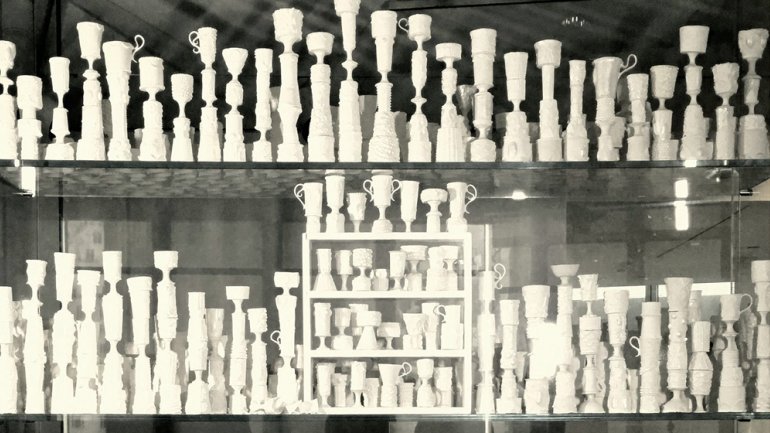The Sweet Life
The Sweet Life
In the world of cake design, Margaret Braun is royalty, famed for edible creations so artfully ornate, they’d have made Marie Antoinette swoon.
Bedecked with ropes and tassels, flowers and flourishes, starbursts and scallop shells, and usually topped with her trademark chalice or crown, Braun’s colorful tiered confections have served as wedding cakes for the likes of Marilyn Manson and Mariah Carey, and earned her a reputation as a trailblazer in the fusion of food and fine art. Now she’s on a new path, applying her skill and signature aesthetic to other mediums, notably ceramics.
“I am in a major transition,” declares the artist, 55. “It’s a dynamic time for me. And I’m having so. Much. Fun.”
Working in clay, she has moved from elaborate and extreme to spare and subtle. “I’ve been a maximalist for all these years. Now I’m breaking it down.” Her handbuilt, thinwalled porcelain pieces – cups, pitchers, plates, goblets, sculp - tural vessels – are animated but refined, in a muted palette with the odd poke of orange or other bright colors. Accented with piping, they look French, confectionary. “You can see the kitchen worker’s hand in the pieces,” she says. As ever, she’s obsessed with silhouette, motif, contrast, symmetry and asymmetry, now distilled to essence.
To Braun, each of the thousands of tiny fleurs-de-lis or curlicues she’s ever drawn has a distinct personality, conveyed through near-imperceptible variations of line and gesture. Similarly, her clay forms have attitudes – “confident, shy, graceful, sad, clumsy, reaching.” They’re unique and imperfect, like people. She enjoys arranging them in groups, exploring their relationships. “We ascribe our ideals onto objects and what we think they are. Maybe I’m looking for the private life in shapes and motifs and objects.”
Braun grew up in Levittown, New York, a midcentury suburb made up of cookie-cutter dwellings. “Every house supposedly was the same, but really they weren’t,” she remembers. “Levittown was a template for individuation, this American dream where you could personalize your home, make a bold statement about who you were and how you differed from your neighbor, while living next to your neighbor and being part of the culture, time, and place.” That notion of identity amid sameness would manifest in her creative work, as she looked within codified design traditions for “opportunities to break away.”
Braun attended art school on and off, never graduating, and never took a class in cake decoration. In the 1980s, as a young painter in New York City, she needed a job and found one at a bakery, where her task was to embellish cakes quickly and by the book. “I was the best and worst production worker, because I’d get bored and have to change it. And I would always be making things on my own,” she recalls. “What I had going for me was a very good hand and a good eye.”
Before long she was baking her own cakes, and her career took off. She developed an original style using time-honored patterns and motifs in audacious ways, an evolution she chronicled in her 2001 book, Cakewalk: Adventures in Sugar with Margaret Braun. But by 2015, she was ready for a change. That year, she did an eight-month residency at New York’s Museum of Arts and Design, handcrafting 2,000 cups – no two alike – out of sugar. It was the perfect segue from cake making to ceramics, a medium she was prompted to try by her friend, sculptor Kathy Ruttenberg: “She gave me a hunk of clay, and it changed my life.”
Today Braun produces most of her pieces at Greenwich House Pottery, the renowned ceramics center just blocks from her Manhattan home. Her tools are the same ones she uses with sugar: rolling pin, paring knife, brush, pastry bag, spatula, scissors, her hands. With firing, of course, the clay process takes much longer than cake making, and is less immediate and predictable, “which is a good challenge for me, because I’m impatient,” she says.
After decades in the food industry, she’s delighted to be working with chefs in a new capacity, making things that get eaten off of instead of eaten (including a series of special-service pieces for Legacy Records, a new restaurant in the city). Naturally, she’s attuned to how food should look on a plate, “like it’s snuggled in a perfect bed or a beautiful sofa, or on a regal stage set.” Sometimes the plate needs to “recede,” one reason her own tableware is a bit “cloudy and mysterious.” She’s begun using her creations for her own dining and entertaining, mostly at the country cabin where she and her husband, Richard Cohen, a psychologist, go to unwind.
While she still loves to make cakes and says she probably will keep making them “forever,” Braun only takes on select projects these days. She’s too busy doing pottery, as well as wall pieces, paintings, and drawings. Creatively speaking, life is sweet. “I feel like I’m starting over,” she marvels. Where this direction will lead, she’s not sure. “I’m giving myself a lot of space to make mistakes. I like the dynamism of not really knowing.”




